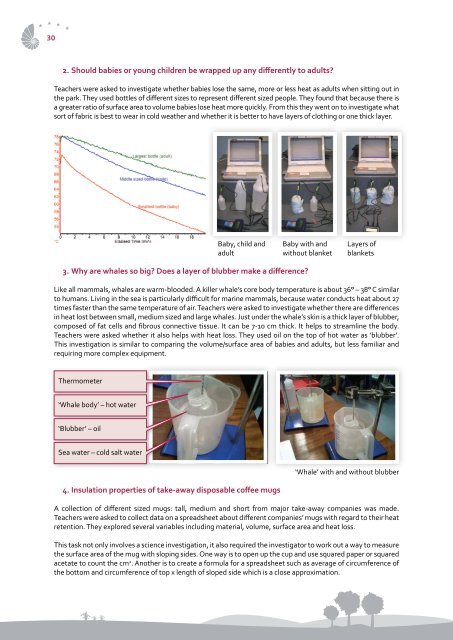Integrating Science Inquiry Across the Curriculum - Fibonacci-Project
Integrating Science Inquiry Across the Curriculum - Fibonacci-Project
Integrating Science Inquiry Across the Curriculum - Fibonacci-Project
You also want an ePaper? Increase the reach of your titles
YUMPU automatically turns print PDFs into web optimized ePapers that Google loves.
30<br />
2. Should babies or young children be wrapped up any differently to adults?<br />
Teachers were asked to investigate whe<strong>the</strong>r babies lose <strong>the</strong> same, more or less heat as adults when sitting out in<br />
<strong>the</strong> park. They used bottles of different sizes to represent different sized people. They found that because <strong>the</strong>re is<br />
a greater ratio of surface area to volume babies lose heat more quickly. From this <strong>the</strong>y went on to investigate what<br />
sort of fabric is best to wear in cold wea<strong>the</strong>r and whe<strong>the</strong>r it is better to have layers of clothing or one thick layer.<br />
Baby, child and<br />
adult<br />
Baby with and<br />
without blanket<br />
Layers of<br />
blankets<br />
3. Why are whales so big? Does a layer of blubber make a difference?<br />
Like all mammals, whales are warm-blooded. A killer whale’s core body temperature is about 36° – 38° C similar<br />
to humans. Living in <strong>the</strong> sea is particularly difficult for marine mammals, because water conducts heat about 27<br />
times faster than <strong>the</strong> same temperature of air. Teachers were asked to investigate whe<strong>the</strong>r <strong>the</strong>re are differences<br />
in heat lost between small, medium sized and large whales. Just under <strong>the</strong> whale’s skin is a thick layer of blubber,<br />
composed of fat cells and fibrous connective tissue. It can be 7-10 cm thick. It helps to streamline <strong>the</strong> body.<br />
Teachers were asked whe<strong>the</strong>r it also helps with heat loss. They used oil on <strong>the</strong> top of hot water as ‘blubber’.<br />
This investigation is similar to comparing <strong>the</strong> volume/surface area of babies and adults, but less familiar and<br />
requiring more complex equipment.<br />
Thermometer<br />
‘Whale body’ – hot water<br />
‘Blubber’ – oil<br />
Sea water – cold salt water<br />
4. Insulation properties of take-away disposable coffee mugs<br />
‘Whale’ with and without blubber<br />
A collection of different sized mugs: tall, medium and short from major take-away companies was made.<br />
Teachers were asked to collect data on a spreadsheet about different companies’ mugs with regard to <strong>the</strong>ir heat<br />
retention. They explored several variables including material, volume, surface area and heat loss.<br />
This task not only involves a science investigation, it also required <strong>the</strong> investigator to work out a way to measure<br />
<strong>the</strong> surface area of <strong>the</strong> mug with sloping sides. One way is to open up <strong>the</strong> cup and use squared paper or squared<br />
acetate to count <strong>the</strong> cm 2 . Ano<strong>the</strong>r is to create a formula for a spreadsheet such as average of circumference of<br />
<strong>the</strong> bottom and circumference of top x length of sloped side which is a close approximation.




